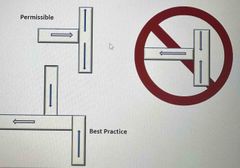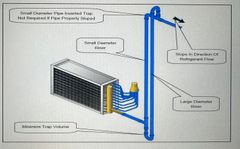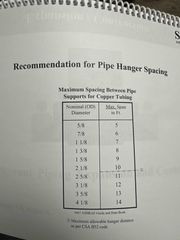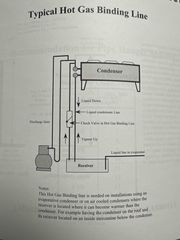![]()
![]()
![]()
Use LEFT and RIGHT arrow keys to navigate between flashcards;
Use UP and DOWN arrow keys to flip the card;
H to show hint;
A reads text to speech;
62 Cards in this Set
- Front
- Back
|
What is a common walk-in cooler SST? Walk-in freezer SST? |
Cooler SST 10F lower than Setpoint
Freezer SST 20F lower than Setpoint |
|
|
What is the normal rule of thumb for picking a condensate line? |
Pick the next size up from the liquid line |
|
|
What is standard PSI drop per foot of vertical lift? |
0.5 psi / ft |
|
|
When sizing suction and discharge lines what are the minimum and maximum velocities? |

Max 3000 Min 1500 |
|
|
What is the maximum velocity for the liquid line? |

300 ft/min |
|
|
What is the maximum velocity for the condensate line? |

120-150 ft/min (according to Dom) |
|
|
How do you get your guesstimate pipe length? Then rough pipe size from section 9? |
You get the rough measurement (excluding amount and types of fittings) and; multiply it by 2 if it is less than 100 ft. Multiply it by 1.5 if it is more than 100 ft. Then you can use sec.9 choosing the correct refrigerant > line type (ex:suction) > SST > capacity > approximate length of pipe > choose pipe size Note: this pipe size may not be correct so you will have to check max/min to ensure pipe size. |
|
|
How do you check the velocity? |
You will need to find the appropriate “velocity in the lines” chart with the appropriate refrigerant. Collect information: capacity and SST (1) select top right > tonnage (2) follow line down till you reach your SST. (3) follow line left till you intersect with a pipe size that fits your min/max. (4)follow the line down till you intersect the velocity indicator that matches your condensing temperature. *note: if the bigger pipe velocity is too HIGH and the next smallest pipe size velocity is too LOW… then pick the smaller pipe because at least the oil will stay in the refrigerant! |
|
|
How do you find your pressure drop per 100 ft? |
(1) once you have selected your proper pipe size that meets your min/max velocity needs …find the pressure drop chart with the correct refrigerant. (2) on the top right corner select the tonnage of the system. (3) follow this line down till you intersect with the correct SST. (4) follow this line left from the intersection till you intersect with your selected pipe size. (5) follow this line down from the pipe size intersect till you reach the pressure drop at your given condenser temperature. (6) you now have psi drop per 100 ft. (BONUS) if you need to find your total pressure drop then you need to find the equivalent pipe length that takes into account all fittings to find the actual pressure drop per actual pipe length. (BONUS BONUS!!!) once you have your total pressure drop of the equivalent pipe length you can find the temperature penalty. Once you find the temperature penalty if it below the maximum (max: 2F suct., 1F liquid, 1F condensate, 1F discharge) If it is below the max temperature penalty then you have the correct pipe size!!! |
|
|
How do you find the equvalent length (length that accounts for all fittings) |
(1)measure the linear feet of line. (2) count all the fittings. (3) go to sec.1 pg 9 “Equivalent lengths of nonferrous Valves and Fittings” (4) add up all the equivalent lengths Note: use long radius LR in all calculations, “service valves” are angle valves in the chart. |
|
|
Once you have the actual pressure drop (1.456 psi drop for the total length including all fittings) how do you find the actual temperature drop? 2F max for suction 1F max for discharge,or condensate or liquid |
(1) if you are looking for the temperature drop in the LIQUID LINE then use the SDT. -find your discharge pressure on the PT chart. Record pressure and temperature at SDT Ex: 404a @ 100F = 235psi (2) then go DOWN 2F to 98F and record the pressure and temperature. (Always go down on the PT chart for suction or discharge calc.) Ex: 404a @ 98F = 229psi (3) now find the equivalent pressure drop for 2F by finding the pressure difference between 100F and 98F 235F-229F = 6psi (4) now take your actual pressure drop of 1.456psi and solve for temperature [(1.456psi/6psi) x (2F)] = 0.485F (5) the suction line can only have a max of 2F temperature penalty while any of the other lines can have a maximum of 1F. 0.485F discharge temperature penalty is smaller than 1F so the pipe sizing is correct. |
|
|
How to find required subcooling due to static lift penalty?
Note: If your condensing unit is BELOW your evaporator as the gas is pumped UP the pressure will go down 0.5psi/ft. We need a solid column of liquid feeding into the evaporator. To ensure that our subcooling at the condenser is enough we have to account for this pressure drop. |
(1) Find the total lift in feet and multiply it by the pressure loss factor to find the pressure drop 8ft lift x 0.5 psi/ft = 4psi (2) Use the condensing temperature and find the pressure with a PT chart. 404a @ 120F = 311psi (3) condensing pressure minus pressure drop 311psi - 4psi = 307psi (4) now find the corresponding temperature on the PT chart 404a @ 307psi = 119F (5) find the actual temperature drop due to lift. 120F-119F= 1F (6) add 1F to the act. Temp. Drop to find required subcooling 1F+1F = 2F is the required subcooling |
|
|
At what box temp is an oil separator required? |
-50F |
|
|
Sizing receiver rules |
90% full at 90F (refrigerant temperature) |
|
|
When do you need a riser? Coupland vs industry standard? |
Coupland: A trap is needs for a lift greater than 3-4 ft. Additional traps every 20ft afterwards.
Industry standard: A trap is needs for a lift greater than 5 ft. Additional traps every 10ft afterwards |
|
|
When do you need double risers? Where is it located? What is the cross sectional area compared to the single riser removed? How does it work? |
(1)When a system has unloaders (2) Can be on the suction or discharge lines (Located in discharge when condensing unit with compressor is on the roof) (3) the cross sectional area of the double riser is approx. equal to the single riser. How does it work? When the system unloads the discharge velocity decreases. The oil drops out of the traving refrigerant and gets trapped in the bottom trap located on the larger double riser pipe. This blocks refrigerant flow diverts completely to the smaller riser. The smaller riser will now have the correct velocity guaranteeing oil return. |
|
|
How do you calculate linear pipe expansion? |
(1)Get the temperature difference: 3 pipe system hot gas line. Hot gas in pipe; in use: 225F Not in use: 70F 225F-70F = 155F (2) find the length of the run in inches 70ft x 12 in/ft = 840 in (3) times length (in) by delta T and expansion factor 840in x 155F x 0.0000104 = 1.45 in |
|
|
Hot gas binding line and condensate line? (1)Rule of thumb for condensate line sizing? (2) why is a hot gas binding line installed? (3) how does a hot gas binding line work? |
(1) condensate line is usually 1 size up from the liquid line. Make sure the velocity is below 120ft/min once you pick the line!) (2) a hot gas binding line is installed to move gas at the top of the receiver to the inlet of the condenser. This is important when the receiver is at a higher ambient temperature than the condenser the system might vapour lock! (Vapour lock can happen with undersized condensate lines, the condensate line will be completely full of liquid so the vapour will not be able to float over it and head back to the condenser) |
|
|
What are some correct discharge piping practices? There are 5 listed |

If condenser is higher than compressor!
(1) use a trap at discharge outlet of compressor to to prevent liquid from sitting on compressor head. (2) make sure trap is as small as possible (3) use inverted trap or check valve at inlet of condenser discharge line to ensure liquid does not drain back (4) if the system has parallel condensing units the equalizer line will be 1 size smaller than the discharge line. (5) if the system has parallel compressors do not bullhead compressors. |
|
|
What are some evaporator best practices? |

Comp. Above evap: use trap
Notice when the the evaps are at the same height there is a drop down. This is to prevent oil from leaving one evap and entering the other.
|
|
|
How do you pipe a double rise? |

Back (Definition) |
|
|
How do you size a double suction riser? |
Record: capacity (5 tons), refrigerant (R-134a), Evap SST (20F), condensing temp (100F), single suction riser pipe (1 5/8 K-copper) Unloaded capacity (50%=2.5 tons)
1) use velocity chart to find SSR velocity ( find velocity with chart > correct refrigerant chart> loaded capacity > SST > pipe size > condenser temp > VELOCITY) 1900 ft/min (2) find the flow area of the SSR pipe (size 1 5/8, K, Sec. 1 pg. 10) Flow area SSR = 1.72 in^2 (3) find the double suction riser smaller, DSR(s), pipe size go to: correct refrigerant velocity chart. Find the pipe that has a velocity of 1900 ft/min @100F, and 2.5 tons, SST 20F) correct refrigerant chart> capacity > SST > pipe size< condenser temp < VELOCITY DSR(s) = 1 1/8” (3) find the flow area of the DSR(s) pipe (size 1 1/8, K, Sec. 1 pg. 10) Flow area DSR(s)= 0.778 in^2 (4) find the estimated flow area of DSR (large) Flow area DSR(L)= flow area SSR - flow area DSR(s) =1.72 in^2 - 0.778 in^2 =0.942 in^2 (5) find the pipe size of DSR(L) (note:answer must be in type K) Estimated DSR(L) = 0.942 in^2 From chart Sec.1 pg.10 Choose either 0.778 in^2 (too small) or 1.22 in^2 (too large) (Note: Choose the closest to the estimated flow area) Choose 0.778 in^2 > 1 1/8 K pipe (5) solve for average velocity [(Flow area SSR)(velocity SSR)]/[(flow area DSR(L))+(flow area DSR(s))] =[(1.72)(1900)]/[0.778)+(0.778)] Avg. Velocity = 2100 ft/min (6) ensure that your DSR has the correct avg. velocity; average velocity is bigger than 1500 ft/min and smaller than 3000 ft/min |
|
|
If your pipe is sized and you find that the temperature penalty is above the acceptible number (2F for suction) THEN you pick the larger pipe size but the velocity is too low. (Below 750 Ft/min) What pipe do you pick??? |
Pick the pipe that has the temperature penalty.
Velocity is more important than temperature penalty. |
|
|
As the diameter of the pipe increases the allowable distance increases. Maximum of…. |

10ft maximum The test picks 8ft as the right answer and then says that the book says 8ft…. But as you can see it says 10…
So pick 8ft |
|
|
Where is the expansion loop located? |
Center of the line |
|
|
According to the DuPont manual how suction piping should be designed for |
2F temp losses |
|
|
The compressor capacity falls as the saturated suction pressure falls, because… |
The returning vapor is less dense |
|
|
Why do they use temperature and not pressure to calculate losses in piping |
Temperature is constant but pressure varies between refrigerant |
|
|
A well designed suction line must |
Return oil to the compressor during minimum load |
|
|
The refrigerant condensate line is between…. |
Condenser and reciever |
|
|
Good refrigerant lines are to be pitched in the direction of flow?
What is the angle of pitch? |
1/2 inch every 10 ft
True |
|
|
Horizontal suction line velocity? |
750 ft/min minimum
But go with 1500 ft/min minimum because its cheaper |
|
|
A properly designed system will return the oil at the same rate? |
True. Mass flow stays the same |
|
|
Maximum velocity of liquid line? |
300 fpm |
|
|
We install an inverted trap on the discharge line when the remote condenser is above the compressor |
Not migration. Refrigerant migration is when refrigerant is attacked to the coldest place in the system.
To prevent liquid from free draining back to the discharge line |
|
|
How are capacity of commercial refrigeration compressors rated? |
Compressors are rated in BTU/hr at a specific suction pressure |
|
|
According to the DuPont manual how suction piping should be designed for |
2F temp losses |
|
|
The compressor capacity falls as the saturated suction pressure falls, because… |
The returning vapor is less dense |
|
|
What is the maximum suction line velocity |
3000 ft/min |
|
|
Why do they use temperature and not pressure to calculate losses in piping |
Temperature is constant but pressure varies between refrigerant |
|
|
Good refrigerant lines are to be pitched in the direction of flow?
What is the angle of pitch? |
True
1/2 inch every 10 ft |
|
|
The refrigerant condensate line is between…. |
Condenser and reciever |
|
|
Good refrigerant lines are to be pitched in the direction of flow?
What is the angle of pitch? |
1/2 inch every 10 ft
True |
|
|
Horizontal suction line velocity? |
750 ft/min minimum
But go with 1500 ft/min minimum because its cheaper |
|
|
We install an inverted trap on the discharge line going into the condenser when the remote condenser is above the compressor??? |
To prevent liquid from free draining back to the discharge line Not migration. Refrigerant migration is when refrigerant is attracted to the coldest place in the system. |
|
|
Maximum velocity of liquid line? |
300 fpm |
|
|
We install an inverted trap on the discharge line when the remote condenser is above the compressor |
Not migration. Refrigerant migration is when refrigerant is attacked to the coldest place in the system.
To prevent liquid from free draining back to the discharge line |
|
|
How are capacity of commercial refrigeration compressors rated? |
Compressors are rated in BTU/hr at a specific suction pressure |
|
|
What is the minimum velocity on the liquid line? |
There is no minimum |
|
|
A condensate line is usually is sized… |
One size larger than the liquid line.
Comdensate |
|
|
The proper temperature penalty is…. |
2F x total pressure drop / pressure drop equivalent to 2F |
|
|
What is the maximum temperature penalty on the suction line? |
2F Everything else is 1F |
|
|
Double risers are used on what types of systems? |
Unloading systems |
|
|
Double risers are used on what types of systems? |
Unloading systems |
|
|
When a liquid line rises 2 ft what is the PSI lose? |
1 PSI |
|
|
Double risers can be used on discharge lines? |
True. |
|
|
The hot gas defrost line must be properly sized to handle the needed hot gas load, this based on…. |
TWICE the evaporator flow rate! |
|
|
The refrigerant condensate line must have what type of flow? |
Sewer type flow. Liquid towards the reciever and gas towards the condenser. Opposite directions in the same pipe. Prevents vapor lock!!! |
|
|
Minimum pressure drop ensures |
(1)Maximum thermal capacity (2)lowers equipment power requirements |
|
|
Oil below refrigerant in receiver. What about in the compressor? |
Its the opposite. Oil is above the refrigerant. |
|
|
When is hot gas binding needed? |

It is needed when the receiver is located inside where it is warmer and the condenser is on the roof. This is because the condensate line will no longer have sewer type flow. |
|
|
This stuff comes up in forth year so remember the velocities? What is the maximum velocity of the condensate line? |
Yep.
Condensate line is 120 ft/min-150 ft/min Next size up from liquid line |

